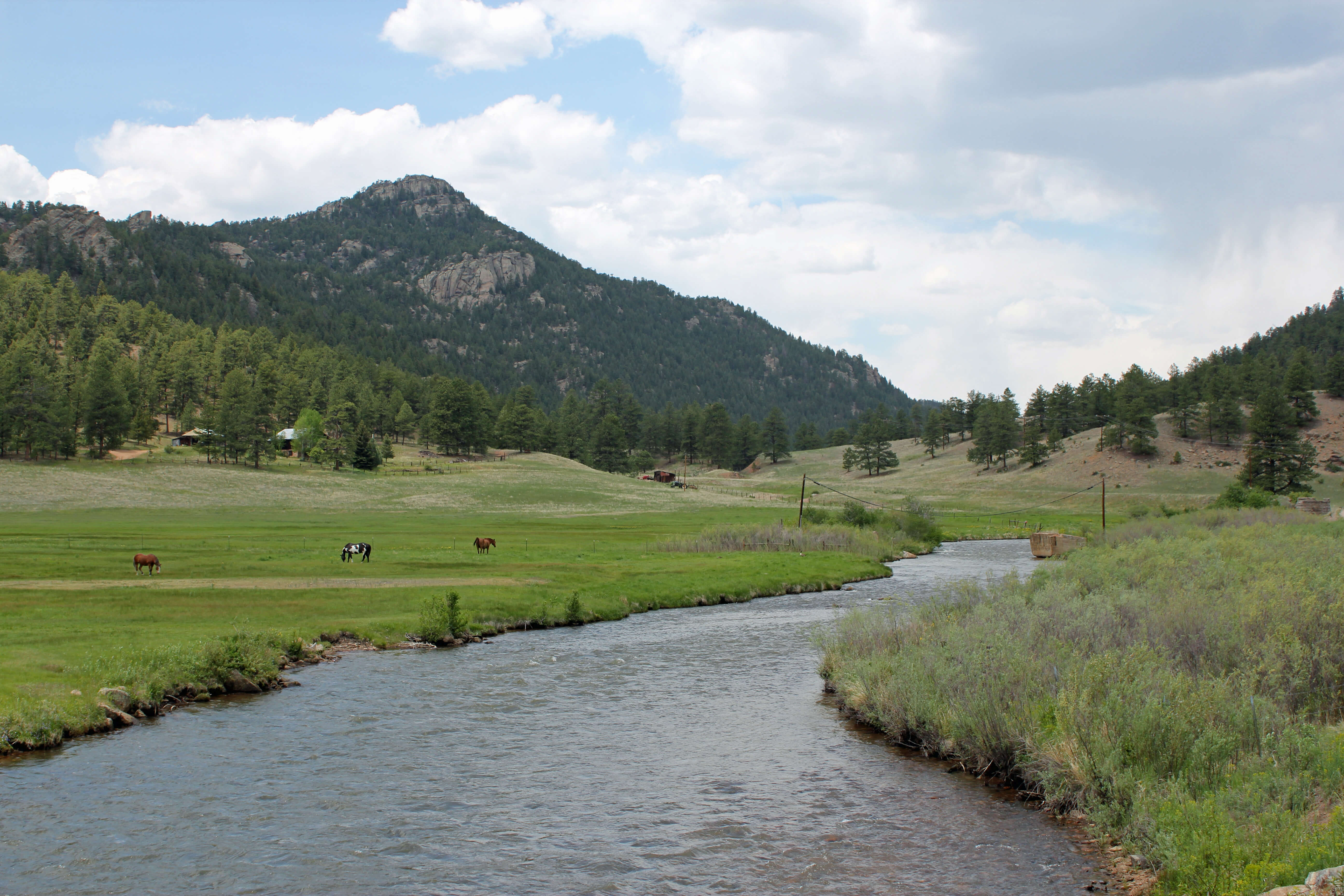


The South Platte River is a popular fishing spot. It is located in southeast Colorado and travels through the Cheesman Canyon to Deckers.
FAST FACTS
The South Platte River system is one of the largest in the country, as it flows north through three states before finally meeting the North Platte River in northern Nebraska and creating the Platte River. The South Platte River as a whole flows for 439 miles and eventually meets the mighty Mississippi River. This pristine river is a very precious resource to the state of Colorado, not only because it provides some of the most epic trout fishing possible, but also because it supplies the Denver Metro Area with a substantial amount of its drinking water.
This waterway begins in Colorado’s high country with three separate arms, the longest of which being the south fork which begins at Montgomery Reservoir in Alma. Under Montgomery Reservoir is a brushy creek which is the true start of the river system and great place for beginners to learn how to fly fish as this section is teeming with aggressive little brook trout willing to play the game. The South Fork provides an excellent beginner section right before entering Antero Reservoir although it does occasionally have issues with low flows. The meeting place of the South and Middle Fork is where the world class fly fishing truly begins, though there are a few areas above worth a visit. The two forks meet in Hartsel in a stretch of river referred to as Badger Basin and under pressured section given the fame of those above and below it (Dream Stream and Tomahawk SWA). This area is probably one of the most heavily pressured fisheries in Colorado, but for good reason as you have realistic options at catching several fish over 20 inches and the species list includes Cutthroat Trout, Rainbow Trout, Brown Trout, CutBow hybrid trout, and Kokanee Salmon.
Once the two forks meet you have pretty much made it out of the headwaters and are now entering a slew of reservoirs and world class fly fishing tailwaters. These tailwaters grow trout to truly impressive sizes as this climate is uniquely perfect for trout forage. These deep reservoirs of this area are chock-full of freshwater shrimp called mysis, damselflies, and baitfish, all of which are excellent protein essential for large fish. This group of reservoirs is very important to Colorado’s trout population as a whole, as a lot of the genetics in Colorado come from Spinney Reservoir where some of Colorado’s broodstock are placed. Once you make it Antero, Spinney, and Eleven Mile Reservoirs you begin to see a more natural stream as it enters Platte Canyon, a canyon made up of many smaller canyons such as Eleven Mile and Waterton. This area is probably the best option for anglers in Denver unwilling to pay the expensive rod fees to access the private water downstream of this area. Once the mainly private waters of the north fork meet the main stem, the water becomes difficult to access once again as things get more private.
Once the river meets the Denver Metro area your best bet at hooking into trout is the Chatfield reservoir where you can also target some harder to find species such as Smallmouth Bass, Walleye, and panfish. As the South Platte leaves Denver, much of the fly fishing opportunity disappears, though you do have chances of catching some football size carp, a battle for any six weight. It may appear that most of this river is private or overcrowded when read about online, but with proper guidance and good mayfly selection this river can be incredibly productive and should be at the very top of every fly anglers bucket list.
The South Platte River is one of the country’s best fishing trout streams, and for good reason at that! This amazing waterway is best fished between Denver and Alma as this is the cold water stretch and supplies vast amounts of food allowing these trout to grow to large sizes in short amounts of time. This river is broken into three separate arms at its headwaters with the south fork being the most publicly accessible and the north fork being the mainly private with rod fees and required guides; the middle fork falls somewhere in between.
The most famous stretch of the river is Charlie Meyers State Wilderness Area (SWA) or as it’s more commonly called the “Dream Stream.” This is an extremely pressured stretch of water located between Spinney and Eleven Mile Reservoirs, known for its 20+ inch Brown Trout, Rainbow Trout, Hybrid Trout, and Kokanee Salmon. In addition to this excellent tailwater, it’s “little brother,” Tomahawk SWA, is another amazing stretch just upstream of the dream stream, living somewhat in its shadow. This stretch should not be overlooked however, as it holds two of my three largest trout landed and is significantly less crowded than the dream stream. Tomahawk SWA is only fishable for three seasons as the flows taper off in fall to unfishable levels in the public section while Charlie Meyers remains fishable year round. These locations are best fished with smaller mayflies, streamers, midges, and during peak summer smaller hopper patterns.
For those looking at options closer to Denver, don’t fret, as the fish quality does not change much as you head further downstream. The Deckers section of water is located just a short drive outside of Denver and is right below Cheeseman Canyon, another amazing section of water. Deckers is equal parts rough and tumble and mellow moving meadow areas giving options for all sorts of different fishing styles and tactics. Cheeseman Canyon is another location right down the road from Denver and is a tactician’s dream with big boulders, shallow tailouts, and abundant subaquatic insects allowing world class euro-nymphing and delicate dry fly action. Whether you are looking for amazing rivers or flourishing lakes, the South Platte system has you covered!
The South Platte’s high country is dotted with several different lakes teeming with trout, some of these waters include Spinney, Eleven Mile, and Antero Reservoirs. These lakes all fish fairly similar and are less than 50 miles apart allowing abundant nutrient for giants to grow to impressive sizes. Antero is the first of the three lakes and was recently drained for repair but is already showing flourishing trout populations since its reopening. Trout are rumored to grow up to two inches a month year-round in this lake. Spinney Reservoir is home to a large broodstock of Colorado’s hybrid genetics and that speaks for itself as to the quality of fish that mature in this reservoir. The last lake to discuss is Eleven Mile which is the reservoir directly downstream of the dream stream, and is typically the stock caught while fishing the legendary section of water. For more info on what’s fishing best during your visit feel free to reach out at (970) 423-7031!